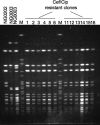Spread of a chromosomal cefixime-resistant penA gene among different Neisseria gonorrhoeae lineages
- PMID: 20028823
- PMCID: PMC2826007
- DOI: 10.1128/AAC.01010-09
Spread of a chromosomal cefixime-resistant penA gene among different Neisseria gonorrhoeae lineages
Abstract
In Neisseria gonorrhoeae, the mosaic type of penA, which encodes penicillin-binding protein 2 (PBP 2), is associated with reduced susceptibility to oral cephalosporins. To investigate the relatedness of N. gonorrhoeae clinical isolates with reduced susceptibility, we sequenced the penA genes of 32 isolates. Five different amino acid sequence types of PBP 2 were identified, but all seemed to be derivatives of pattern X of PBP 2 (PBP 2-X). However, multilocus sequence typing of the isolates showed that the isolates belonged to six different sequence types. As PBP 2-X was identified in three different sequence types, horizontal transfer of the penA allele encoding PBP2-X was suggested. We demonstrated that the penA gene could be transferred from an isolate with reduced susceptibility to a sensitive isolate by natural transformation. Comparison of the sequence of the penA-flanking regions of 12 transformants with those of the donor and the recipient suggested that at least a 4-kb DNA segment, including the penA gene, was transferred. During horizontal transfer, some of the penA alleles also acquired variations due to point mutations and genetic exchange within the allele. Our results provide evidence that the capacity for natural transformation in N. gonorrhoeae plays a role in the spread of chromosomal antibiotic resistance genes and the generation of diversity in such genes.
Figures




Similar articles
-
Emergence and spread of Neisseria gonorrhoeae clinical isolates harboring mosaic-like structure of penicillin-binding protein 2 in Central Japan.Antimicrob Agents Chemother. 2005 Jan;49(1):137-43. doi: 10.1128/AAC.49.1.137-143.2005. Antimicrob Agents Chemother. 2005. PMID: 15616287 Free PMC article.
-
Various penA mutations together with mtrR, porB and ponA mutations in Neisseria gonorrhoeae isolates with reduced susceptibility to cefixime or ceftriaxone.J Antimicrob Chemother. 2010 Apr;65(4):669-75. doi: 10.1093/jac/dkp505. Epub 2010 Jan 21. J Antimicrob Chemother. 2010. PMID: 20093260 Free PMC article.
-
Rapid detection of the mosaic structure of the Neisseria gonorrhoeae penA Gene, which is associated with decreased susceptibilities to oral cephalosporins.J Clin Microbiol. 2008 May;46(5):1804-10. doi: 10.1128/JCM.01800-07. Epub 2008 Mar 26. J Clin Microbiol. 2008. PMID: 18367575 Free PMC article.
-
Neisseria gonorrhoeae isolates with reduced susceptibility to cefixime and ceftriaxone: association with genetic polymorphisms in penA, mtrR, porB1b, and ponA.Antimicrob Agents Chemother. 2007 Jun;51(6):2117-22. doi: 10.1128/AAC.01604-06. Epub 2007 Apr 9. Antimicrob Agents Chemother. 2007. PMID: 17420216 Free PMC article.
-
The use of cephalosporins for gonorrhea: the impending problem of resistance.Expert Opin Pharmacother. 2009 Mar;10(4):555-77. doi: 10.1517/14656560902731993. Expert Opin Pharmacother. 2009. PMID: 19284360 Free PMC article. Review.
Cited by
-
Differential contribution of PBP occupancy and efflux on the effectiveness of β-lactams at their target site in clinical isolates of Neisseria gonorrhoeae.PLoS Pathog. 2024 Dec 31;20(12):e1012783. doi: 10.1371/journal.ppat.1012783. eCollection 2024 Dec. PLoS Pathog. 2024. PMID: 39739989 Free PMC article.
-
Characterizing the diversity and commensal origins of penA mosaicism in the genus Neisseria.Microb Genom. 2024 Feb;10(2):001209. doi: 10.1099/mgen.0.001209. Microb Genom. 2024. PMID: 38381035 Free PMC article.
-
Proteochemometric model for predicting the inhibition of penicillin-binding proteins.J Comput Aided Mol Des. 2015 Feb;29(2):127-41. doi: 10.1007/s10822-014-9809-0. Epub 2014 Oct 26. J Comput Aided Mol Des. 2015. PMID: 25344841
-
Emergence of multidrug-resistant, extensively drug-resistant and untreatable gonorrhea.Future Microbiol. 2012 Dec;7(12):1401-22. doi: 10.2217/fmb.12.117. Future Microbiol. 2012. PMID: 23231489 Free PMC article. Review.
-
Genome sequencing of a Neisseria gonorrhoeae isolate of a successful international clone with decreased susceptibility and resistance to extended-spectrum cephalosporins.Antimicrob Agents Chemother. 2012 Nov;56(11):5633-41. doi: 10.1128/AAC.00636-12. Epub 2012 Aug 20. Antimicrob Agents Chemother. 2012. PMID: 22908152 Free PMC article.
References
-
- Aas, F. E., M. Wolfgang, S. Frye, S. Dunham, C. Lovold, and M. Koomey. 2002. Competence for natural transformation in Neisseria gonorrhoeae: components of DNA binding and uptake linked to type IV pilus expression. Mol. Microbiol. 46:749-760. - PubMed
-
- Akasaka, S., T. Muratani, Y. Yamada, H. Inatomi, K. Takahashi, and T. Matsumoto. 2001. Emergence of cephem- and aztreonam-high-resistant Neisseria gonorrhoeae that dose not produce beta-lactamase. J. Infect. Chemother. 7:49-50. - PubMed
-
- Ameyama, S., S. Onodera, M. Takahata, S. Minami, N. Maki, K. Endo, H. Goto, H. Suzuki, and Y. Oishi. 2002. Mosaic-like structure of penicillin-binding protein 2 gene (penA) in clinical isolates of Neisseria gonorrhoeae with reduced susceptibility to cefixime. Antimicrob. Agents Chemother. 46:3744-3749. - PMC - PubMed
Publication types
MeSH terms
Substances
Associated data
- Actions
- Actions
- Actions
- Actions
- Actions
LinkOut - more resources
Full Text Sources
Other Literature Sources
Medical
Research Materials
Miscellaneous

